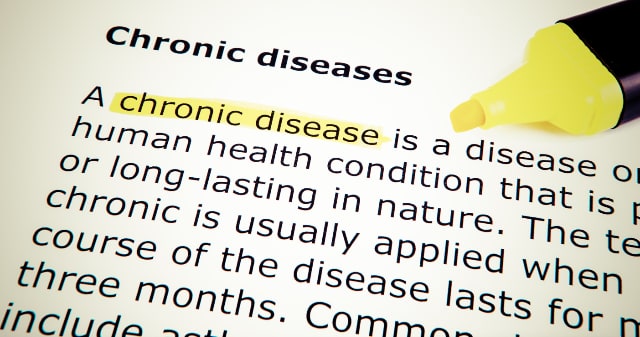
The Prevalence of Chronic Disease
Disease Exercise Financial Nutrition Sleep Stress
Everyone has likely heard of chronic diseases. But few people know just how prevalent they are. They have been on the rise for several generations and are seriously impacting our health, finances, and productivity.
What Is Chronic Disease?
The Centers for Disease Control (CDC) defines chronic disease as a condition "that last(s) 1 year or more and require(s) ongoing medical attention or limit(s) activities of daily living or both."
Nearly half of all Americans have a chronic disease, including young people. One out of every four young adults is too overweight to serve in the military.

It does not matter what caused the disease. It does not matter which parts of the body are impacted by the disease. Duration, continuous medical treatment, and disability serve as the bases for the definition.
A person may suffer from multiple chronic diseases at once. In fact, two in five adults in the United States have two or more diseases.
"Chronic" does not mean "incurable." Many chronic diseases have cures. If they don't, they have treatment plans that can decrease the severity of symptoms.
A chronic disease may go away only to resurface later. A person may survive one chronic disease, only to have another one.
An injury may cause medical treatment for a year or longer. But an injury in itself is not a chronic disease unless the injury causes one.
Chronic disease can occur at any point in a person's life. Many diseases are age-related, but even children can get one. A person may be born with a chronic disease, or they may acquire one through life.
What Are the Most Prevalent Chronic Diseases?
There are many diseases that are prevalent. We can break them into categories based on what part of the body they affect. Some diseases may affect multiple parts at once, so this is a rough categorization.
A rare chronic disease can still be devastating. For example klinefelter syndrome is a genetic disorder that affects one in every 650 newborn boys, and increases the risk for a number of ailments, including depression and breast cancer.
Yet the most common diseases are equally devastating. Here are brief descriptions with examples.
Chronic Kidney Disease
The kidneys control the urinary and endocrine systems. They allow wastes to enter the urine and leave the body. They control hormone rates, regulating the acid-base balance in the blood.
Chronic kidney disease means the kidneys cannot filter blood. Excess fluids and wastes build up in the body, triggering cardiovascular disease and organ failure. Increased water consumption can clear out wastes, but more extensive measures are needed.
The kidneys may stop working entirely. Dialysis filters and purifies the blood, allowing the body to continue working. On occasion, a transplant may be needed.
15 percent of American adults have chronic kidney disease. Diabetes is a leading cause of kidney failure, though it is not a kidney disease in itself. High blood sugar rates damage the kidneys because the kidneys have to clean out so much sugar from the blood.
Chronic Lung Disease
The lungs are the center points of the respiratory system. They extract oxygen from the air and bring it into the bloodstream while releasing carbon dioxide.
Chronic lung disease can impact the lungs in a few different ways. Obstructive lung diseases limit the amount of air that can enter the lungs. Obstructive diseases include asthma and COPD.
Restrictive lung diseases limit the amount of lung tissue that can handle oxygen. Examples include pulmonary fibrosis, which replaces lung cells with connective tissues.
Nine percent of American adults suffer from asthma. Most people with asthma can live full lives. But COPD and fibrosis can cause long-lasting complications, including lung failure and death.
Chronic Heart Disease
The heart is the center point of the cardiovascular system. It pumps blood, carrying oxygen and nutrients throughout the body.
Different diseases can impact the heart in different ways. Coronary artery disease narrows the blood vessels, reducing blood flow to the heart. Cardiomyopathy is a disease of the heart muscles so they cannot pump blood at a high rate.
A heart attack is not in and of itself heart disease. Coronary artery disease causes many heart attacks by reducing the flow of blood to the heart muscle. A heart attack can cause chronic problems if the muscle tissue does not repair itself.
Any heart disease is dangerous. One person dies from a cardiovascular disease every 36 seconds in the United States. Any kind of heart ailment can lead to cardiac arrest or a stroke.
Brain Disease
The most common chronic brain disease is Alzheimer's. The brain wastes away, decreasing in size and function until a person is unable to speak or move.
Alzheimer's disease does not kill people in itself, but it destroys all brain functions. More than five million Americans are living with Alzheimer's.
More and more scientists consider drug addiction to be a chronic disease. Addiction alters the reward system of the brain, skewing it toward drugs and alcohol.
A person needs stronger doses of drugs to receive a rush of dopamine, the pleasure hormone. They may only receive dopamine if they take drugs. This results in a high dependency that does not end until a person receives treatment.
More than 20 million Americans struggle with substance abuse. The categorization of addiction as a brain disease is controversial, but it is becoming more common. More people may be able to receive help if consensus about addiction as a brain disease builds.
Autoimmune Disease
The immune system fights off infections, viruses, and cancer cells. An autoimmune disease occurs when the immune system accidentally attacks healthy body tissues.
HIV/AIDS is one of the most notorious chronic diseases. The human immunodeficiency virus (HIV) attacks immune cells, leaving the body open to infection. Acquired immunodeficiency syndrome (AIDS) occurs after HIV has destroyed enough immune cells that the person contracts cancers like Kaposi's sarcoma.
Lupus is another common autoimmune disease. The immune system becomes hyperactive, attacking tissues throughout the body.
Autoimmune diseases are tricky because they attack multiple parts of the body at once. Lupus can impact the skin, joints, kidneys, and heart.
Cancer
Cancer occurs when cells grow at an abnormal rate. Healthy cells receive signals to grow, but cancer cells grow without and in spite of signals. Left untreated, cells spread into other tissues and disrupt their progress.
A person can develop cancer in virtually any part of the body. Lung, breast, and colon cancers are among the most common forms.
Cancer might be the most prevalent chronic disease. 40 percent of men and women will receive a cancer diagnosis at some point in their lives. Some people survive one round of cancer, only for their cancer to return.
Death rates are going down. But the survival rates for brain, pancreatic, and esophageal cancer remain low.
What Are the Costs of Chronic Diseases?
The United States spends nearly four trillion dollars every year on health care. Roughly 90 percent of expenditures are for people with chronic conditions.
But the costs of chronic diseases go beyond health care expenses. Many people are unable to work because of their condition.
Even if they can work, they miss appointments and take fewer responsibilities. This all results in a loss of productivity. Productivity is difficult to measure, so cost figures may be conservative.
Heart diseases cost 214 billion dollars every year in health care expenses. But it also causes 138 billion dollars in lost productivity. Combining both figures, heart diseases cost 352 billion dollars a year.
The total cost of diabetes is 327 billion dollars, including both medical costs and productivity losses. But this cost is for people with diagnosed diabetes. Undiagnosed cases may cost the country billions of dollars more.
Alzheimer's disease costs 305 billion dollars. Patients require skilled nurses, usually at facilities like nursing homes. The round-the-clock care they provide leads to substantial costs.
Chronic diseases lead to high costs for a number of reasons. Patients can live with a chronic disease for decades, which naturally leads to high costs. They need ongoing treatments, sometimes daily, which also drives the expenses up.
Why Are They Increasing?
People tend to live with chronic diseases more than they die from them. If you are diagnosed with one, you may be able to live a full life for at least several years.
But rates of chronic diseases will go up over time. Nearly 14 million Americans will have Alzheimer's disease by 2050. This is in spite of advanced treatments for the disease.
One reason that rates might be going up is that training has improved. Doctors now know the many causes and symptoms of diseases. Cases of cancer or diabetes that would have gone undiagnosed are now spotted, which drives up the reported numbers.
Another reason is that people are living longer. Though life expectancy rates went down this year, they have gone up by nearly a decade since the 1960s. Living longer means a person has more time to contract a chronic disease.
There are several risk factors as well. Millions of Americans continue to smoke cigarettes. Smoking is a leading cause of lung cancer and respiratory ailments like COPD.
Excessive alcohol use is associated with addiction. But it can also cause liver damage and colon cancer. The body converts alcohol into chemicals that can damage DNA and cause abnormal cell growth.
Millions of Americans don't exercise and eat a healthy diet. Either can lead to heart disease, cancers, and diabetes.
The continued impacts of climate change may increase chronic disease rates. Air pollution can cause respiratory ailments.
What Are the Solutions?
Thankfully, there are many solutions for chronic diseases. The first is to be aware of causes and symptoms. If you notice you have symptoms, go to a doctor right away.
Chronic diseases may have genetic components. If someone in your immediate family had a heart attack before age 50, your chance of a heart attack is high. Being familiar with your family history is important.
To avoid heart disease and diabetes, practice mindful eating. Before you sit down to eat, take notice of why you are eating. Consider how hungry you are and what you are hungry for.
Take a bite, then put your utensil down. Chew it using both sides of your mouth and your tongue. Eat without distractions, including television and music.
Pause and evaluate how hungry you are. Then take another bite. This process will train you to stop when you are full, avoiding overeating.
The standard American diet is full of red meat, processed grains, and sugars. Eat at least two cups of fruits and vegetables every day. Drink water instead of alcohol or soda.
Exercise for at least 30 minutes every day. You do not have to be labor-intensive. You can go for a walk, jog up stairs, or lift weights.
Get at least eight hours of sleep every night. Sleep allows your body to rest and repair itself after a long day. Clear your bedroom of all distractions to allow yourself to rest completely.
The Scourge of Chronic Disease
Chronic disease is not going away. But we can fight it with the facts.
A chronic disease impacts a person for at least one year. It requires ongoing medical attention or limits mobility. Examples include COPD, HIV/AIDS, and cancer.
Chronic diseases cost billions of dollars every year. Despite advanced treatments, they are increasing because of Americans' sedentary lifestyle.
Stop smoking and start eating healthy foods. Get out and exercise, but make sure to sleep eight hours.
Get help when you need it.

Jay Todtenbier co-founded SupplementRelief.com in 2010 and continues to lead its mission of helping people live healthier, more balanced lives. In addition to his work in wellness, he teaches tennis and serves as a gospel musician on his church's worship team. Before SupplementRelief.com, he spent 25 years in business development, technology, and marketing. After struggling with depression, autoimmune disorders, and weight issues, he became passionate about living a healthier life. He advocates small, sustainable lifestyle changes— eating real food, moving regularly, nurturing a healthy mindset, and using high-quality supplements when needed—to support lasting vitality.
Learn more about Jay Todtenbier.
-
 Discussion Forum
Questions or Feedback?
Discussion Forum
Questions or Feedback?Ask questions. Share your thoughts. Note that we cannot answer questions relating to specific medical conditions - please refer those to your qualified healthcare provider.
Post a new Comment or Reply to an existing one. Help for using the Discussion Forum.
 Discussion Forum Help
Discussion Forum Help
Comments are displayed in order of the last one posted so the most recent one is at the top and the oldest one at the bottom.
Replies within a Comment are displayed in reverse order with the oldest one at the top and the most recent one at the bottom.
Each post identifies
 who made the post and the
who made the post and the  date and time the post was made.
date and time the post was made.Mouse over the icons for tooltips that explain what they mean.

If you see this icon you can attach an Audio file to your post.

If you see this icon you can attach a Document file to your post.

If you see this icon you can attach an Image file to your post.

If you see this icon you can attach a Video file to your post.
You will see the
 Ban icon (Report Post as SPAM) immediately following the Timestamp of the post. Click this icon if you feel strongly that the content posted is not appropriate and should be reviewed by the Forum Moderator. You will be provided with a confirmation dialog to be sure you wish to submit this post for review. If submitted, the Forum Moderator will be notified to review the post and will determine what type of action to take.
Ban icon (Report Post as SPAM) immediately following the Timestamp of the post. Click this icon if you feel strongly that the content posted is not appropriate and should be reviewed by the Forum Moderator. You will be provided with a confirmation dialog to be sure you wish to submit this post for review. If submitted, the Forum Moderator will be notified to review the post and will determine what type of action to take.Click
 in the upper right corner of this Help modal or anywhere on the web page outside of the modal to exit Help.
in the upper right corner of this Help modal or anywhere on the web page outside of the modal to exit Help.
![]() Session Expired from Inactivity
Session Expired from Inactivity
Do you want to?
9618 Jefferson Highway, Suite D-191
Baton Rouge LA 70809-9636
(888) 424-0032 |
support@supplementrelief.com
* Disclaimer: This page is available exclusively for SupplementRelief.com clients. None of the information on this website is intended to replace your relationship with your healthcare provider(s). Nothing should be considered medical advice. The information, knowledge, and experience shared on this website are the opinions of SupplementRelief.com. This site and its content are intended to enhance your knowledge base as YOU MAKE YOUR OWN HEALTHCARE DECISIONS in partnership with your qualified health professional.
* These statements have not been evaluated by the Food and Drug Administration. These products and services are not intended to diagnose, treat, cure, or prevent disease.
* There is NO GUARANTEE OF SPECIFIC RESULTS for the products or services offered, and the RESULTS CAN VARY for each individual. Any results claimed by our customers are based on individual experiences that are unique and cannot be guaranteed.
FirstFitness Nutrition and NuMedica may be promoted and sold on the internet ONLY by Authorized Resellers who have been approved by and have registered their website domain with these companies. They strictly prohibit, and actively monitor, the UNAUTHORIZED SALE or RESALE of their products in ALL online public shopping portals including Amazon, eBay, and others and into other countries. All products purchased in SupplementRelief.com are for PERSONAL USE ONLY and CANNOT BE RESOLD to others. Please report violations of Reseller Policy directly to FirstFitness Nutrition at 800.621.4348 and to NuMedica at 800.869.8100.
The content and photographs on this website are copyrighted or Licensed Material and may not be downloaded for other than personal use. Republication, retransmission, reproduction, or any other use of the content or photographs is prohibited. ©2010-2024 SupplementRelief.com.
Are you sure you want to remove this item?

